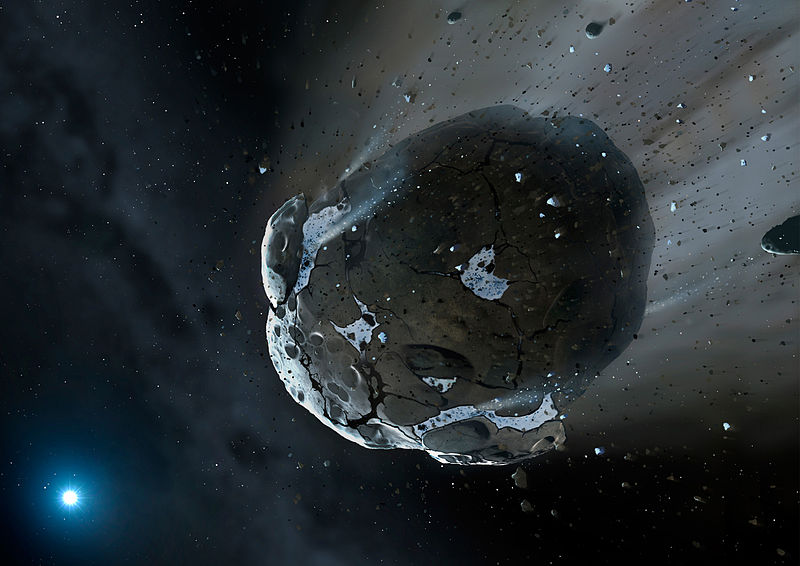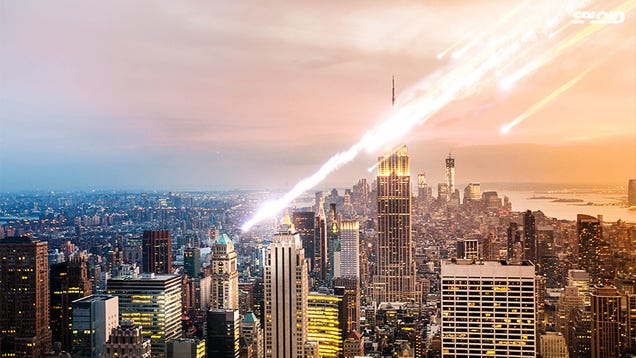Asteroid Collisions 'Common':
Scientists Record 26 Nuclear-Scale Explosions on Earth

Asteroid
strike: 26 nuclear-scale collisions with Earth were recorded between 2000 and
2013 - Wiki Commons
 By Lydia Smith
By Lydia SmithAsteroid strikes on Earth are more common than we realise, according to a visualisation showing where large meteorites have collided with our planet in recent years.
The B612 Foundation, a US-based group of Nasa asteroid monitors who campaign on the issue of space protection, have revealed that 26 nuclear-scale explosions were caused by minor planets striking Earth between 2000 and 2013.
In one case, the blast was more powerful than the 15-kiloton atom bomb which destroyed Hiroshima in 1945. The impacts were recorded by the Comprehensive Nuclear-Test-Ban Treat Organisation (CTBTO), in which infrasound sensors capture clandestine bomb explosions.
Dr Ed Lu, a former Nasa astronaut, warned that the asteroids were large enough to wipe out extensive areas on the planet, including entire cities, as the meteorites were not detected or tracked in advance by any Earth or space observatories.
Although the majority of the asteroids were too high in the atmosphere to cause any serious damage, the frequency of the strikes reveal just how vulnerable Earth is.
Presenting the organisation's findings at the Museum of Flight in Seattle, Dr Lu said: "While most large asteroids with the potential to destroy an entire country of continent have been detected, less than 10,000 of the more than a million dangerous asteroids with the potential to destroy an entire major metropolitan area have been found by all existing space or terrestrially-operated observatories."
The energy of the asteroid impacts ranged from one to 600 kilotons. In February 2013, an asteroid measuring 20m wide hit the Russian city of Chelyabinsk with a flash of light brighter than the Sun, even at a 100km distance.
Yet the strike itself was minute in comparison with other events recorded on Earth. In 1908, a 45m-wide meteor struck a remote corner of Earth.
Dr Lu told BBC News that the strikes can be monitored in the same way as earthquakes: "In the cities that have a major danger - Tokyo, Los Angeles, San Francisco - they know the odds of big earthquakes by observing how many small earthquakes there are.
"Because there's a known distribution of earthquakes, meaning that earthquakes come in all sizes, small to large - if I can measure the small ones, I know how many big ones they're going to be. And you can do this with asteroids.
"These asteroid impacts in the last decade have been ones that we haven't had much data on until recently, and they tell us that in fact asteroid impacts are more common than we thought."
The B612 Foundation has proposed its Sentinel telescope, a space observatory currently in development with Ball Aerospace, designed to locate 90% of the asteroids greater than 140m in diameter that exist in near-Earth orbits. The project is expected to be ready for launch in 2018 and would help detect meteors hidden by the Sun's glare.
Information from Nasa's Wise telescope suggests that there may be 20,000 objects between 100 and 1,000m in size which are yet to be identified and tracked.
"Picture trying to spot something that's only the size of a small apartment building, that's tens of millions of miles from Earth, and that's black against a black background," Lu added. "That's incredibly hard. That's what requires the technological advances of Sentinel."
From International Business Times @ http://www.ibtimes.co.uk/asteroid-collisions-common-scientists-record-26-nuclear-scale-explosions-earth-1445696
Risk of asteroid hitting Earth is ten times higher than we thought

Illustration
by Jesús Díaz/Base image by ShutterStock
This is
frightening. Nature just published a study
by astronomers who
have reanalyzed and recalculated the estimate of asteroids that could hit Earth
and it's a lot worse than we thought. Ten
times worse.
Here's the thing. Researchers have always had a fairly decent track record in spotting humungous asteroids that might hit Earth. That's because NASA previously only looked for space rock 100 feet wide and bigger. But in the aftermath of the meteorite that exploded over Russia, they're beginning to realize that smaller asteroids are still insanely powerful and damaging and desperately need to be kept track of too.
For example, the meteorite in Russia was only 62 feet wide but still exploded over Earth with the force of 40 Hiroshima-type atom bombs. Imagine that over a big city like New York. Imagine that over millions of people. These smaller asteroids might not be apocalyptic but if any of these smaller meteorites hit Earth near a large population of people, the damage would be catastrophic.

Russians just found a giant space boulder from the Chelyabinsk meteor
We have completely underestimated the risk of smaller asteroids. And we're only beginning to catalog them. Using old methods like basic telescope data had estimated things like the Russian meteorite happening once every 150 years. The data that the new team has dug up shows occurrences every 30 years. It's just because they happened over the ocean or in remote parts of the world that we don't know about them. The research team estimates the strike rate of asteroids as two to 10 times as likely than before.
So are we just screwed? Is this what will end Earth? Are we going to where the dinosaurs went? We don't have to be. Brown believes that we can build systems to find these smaller asteroids days and weeks before they hit. We have technology! We can figure out where and when they'll hit us. So let's hope our governments can get their acts together and implement such warning systems. It's our best chance.
From Sploid @ http://sploid.gizmodo.com/threat-of-asteroid-hitting-earth-is-way-more-likely-tha-1459846910
For more information about asteroids see http://nexusilluminati.blogspot.com/search/label/asteroids
- See ‘Older Posts’ at the end of each section
Hope you like this
not for profit site -
It takes hours of work every day
to maintain, write, edit, research, illustrate and publish this website from a
tiny cabin in a remote forest
Like what we do? Please give enough
for a meal or drink if you can -
Donate any amount and receive at least one New Illuminati eBook!
Please click below -
Videos -
For further enlightening
information enter a word or phrase into the random synchronistic search box @ http://nexusilluminati.blogspot.com
And see
New Illuminati – http://nexusilluminati.blogspot.com
New Illuminati on Facebook - https://www.facebook.com/the.new.illuminati
New Illuminati Youtube Channel - http://www.youtube.com/user/newilluminati/feed
New Illuminati on Google+ @ https://plus.google.com/115562482213600937809/posts
New Illuminati on Twitter @ www.twitter.com/new_illuminati
New Illuminations –Paintings in
Light by R. Ayana @ http://newilluminations.blogspot.com
The Her(m)etic Hermit - http://hermetic.blog.com
The Prince of Centraxis - http://centraxis.blogspot.com (Be Aware! This link leads to implicate &
xplicit concepts & images!)
DISGRUNTLED SITE ADMINS PLEASE NOTE –
We provide a live link to your original material on your site (and
links via social networking services) - which raises your ranking on search
engines and helps spread your info further! This site is
published under Creative Commons Fair Use Copyright (unless an individual
article or other item is declared otherwise by the copyright holder) –
reproduction for non-profit use is permitted & encouraged, if you
give attribution to the work & author - and please include a (preferably
active) link to the original (along with this or a similar notice).
Feel free to make non-commercial hard (printed) or software copies or
mirror sites - you never know how long something will stay glued to the web –
but remember attribution! If you like what you see, please send a donation (no
amount is too small or too large) or leave a comment – and thanks for reading
this far…
Live long and prosper! Together we can create the best of all possible
worlds…
From the New
Illuminati – http://nexusilluminati.blogspot.com

No comments:
Post a Comment
Add your perspective to the conscious collective